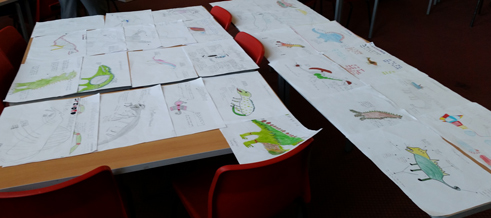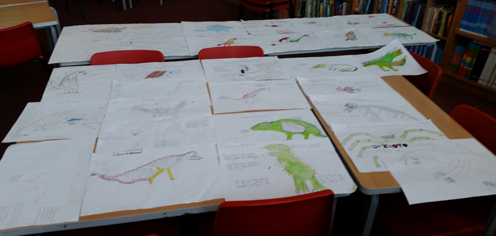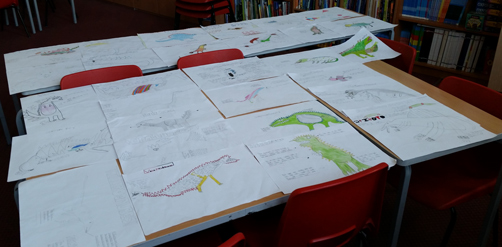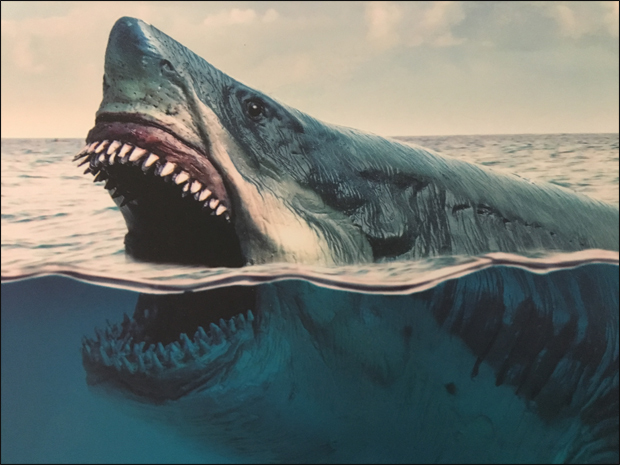Fossils Help Explain about Extinction
For children in Year six at Lomeshaye Junior School, Monday saw a change in their classroom routines. One of the rooms used by the three classes was taken over for the day by a fossil expert from Everything Dinosaur. Hopefully, the reshuffle was worth it as Ash, Rowan and Elder were able to examine fossils from animals that lived many millions of years ago and learn about extinction events. The budding young palaeontologists have been learning about what animals need in order to survive and how animals can adapt to live in different environments.
Creating Dinosaurs – A School Activity
Helped by Yousuf and Conain, the schools resident dinosaur experts, the children explored how fossils form and examined a mystery that concerns one of the most famous dinosaurs of all, the plant-eating dinosaur Triceratops. Time for the children to become “dinosaur detectives” to use scientific working to look at evidence and to decide upon a theory that supports the fossil record.
Looking at Fossils and Extinction Events
We looked at fossils and learned how scientists interpret fossils to help them understand creatures that lived in the past. Using fossils the children looked at how animals are adapted to suit their environment and when the environment changes then extinctions can occur. Time to introduce information on the bizarre Coelacanth as well as the awesome “teacher swallowing in one bite” Carcharodon megalodon or to use its other name Otodus megalodon*.
The children in Mr Smith’s class were challenged to design their own dinosaur. Our expert wanted to see what adaptations the children would give their creation to help it survive. We had some amazing designs and the children demonstrated how they could apply their knowledge to the task.
Year Six Children Create Their Very Own Prehistoric Monsters
Picture credit: Everything Dinosaur
Creating Dinosaurs
One of the animals designed was very round and fat. Our fossil expert listened carefully as it was explained to him, that the fat layers that this dinosaur had helped to it keep warm – very clever.
The Colourful Dinosaurs Helped Demonstrate How Animals Adapt
Picture credit: Everything Dinosaur
One little boy described his dinosaur and outlined how it was venomous, with one bite from its teeth able to paralyse prey. What a fascinating idea! One that has been backed up by some scientists who have been studying the fossilised bones and teeth of a predatory dinosaur from China. The dinosaur called Sinornithosaurus (sigh-no-orn-nith-oh-sore-us), the name translates as “Chinese Bird Lizard”, may have had a venomous bite.
A Venomous Dinosaur
To read about a potentially venomous dinosaur discovery: Dinosaur with a Venomous Bite?
Laid out on the Tables the Drawings Made a Very Colourful Display
Picture credit: Everything Dinosaur
Even Mr Lawless, one of the dedicated learning support team members, had a go. His spider influenced design showed great imagination and our dinosaur expert loved the blue and yellow head crest.
Dinosaur and Fossil Workshop
It looks like the dinosaur and fossil workshop has helped inspire and enthuse teachers as well as pupils as Year six examines how environments change and animals adapt in order to survive.
* Carcharodon megalodon or Carcharocles megalodon, there is still some debate as to how this giant shark should be classified. Please note, this prehistoric shark is classified as Otodus megalodon.
The PNSO Megalodon Model – A Prehistoric Shark that Faced Extinction
PNSO have introduced a variety of prehistoric fish figures including Megalodon, Helicoprion, Dunkleosteus and Cretoxyrhina: PNSO Age of Dinosaurs Models and Figures.









